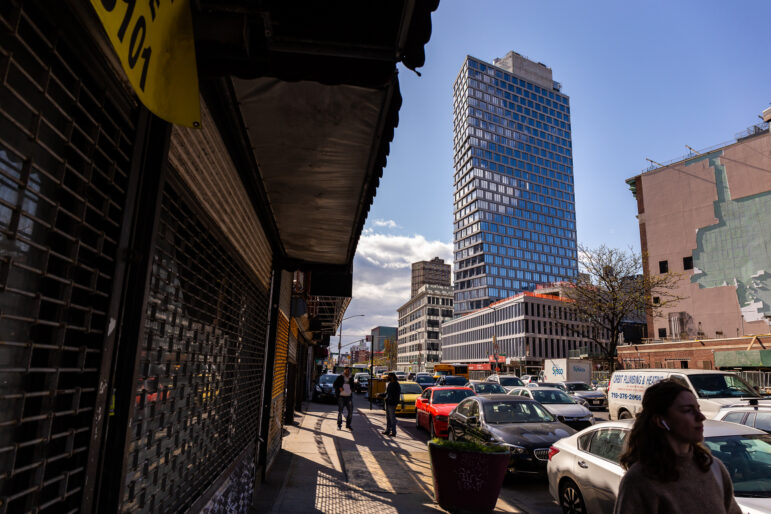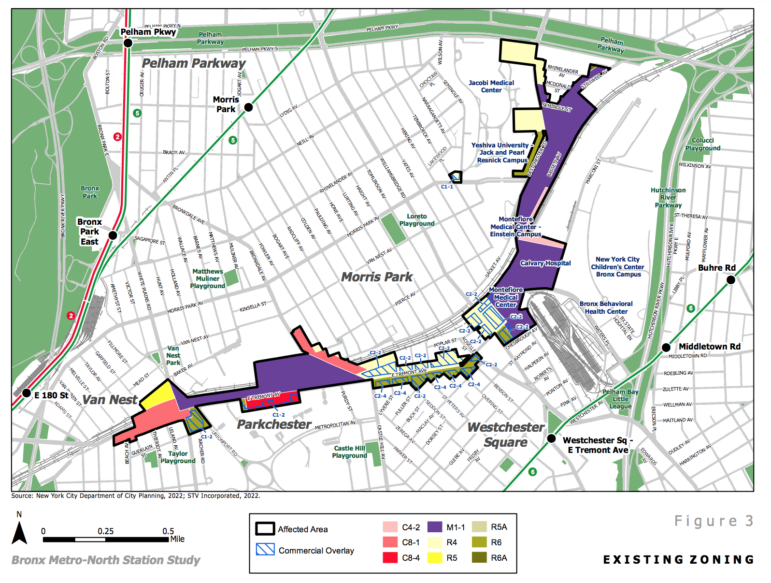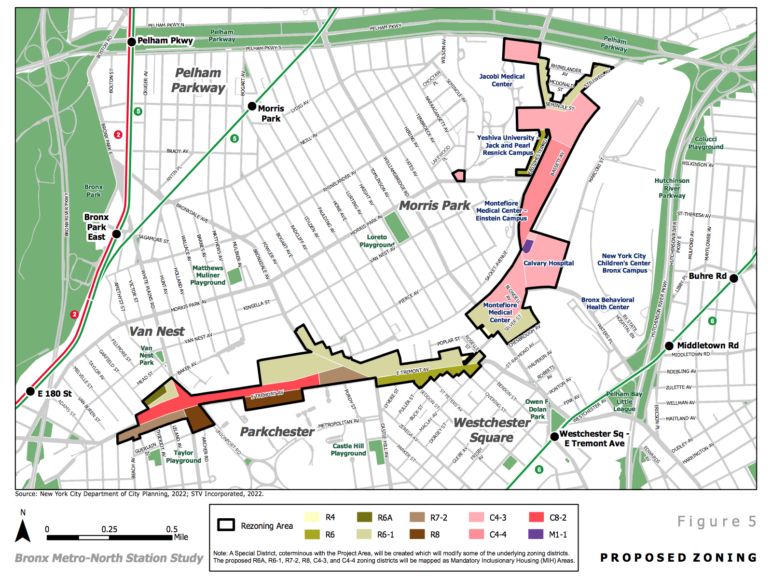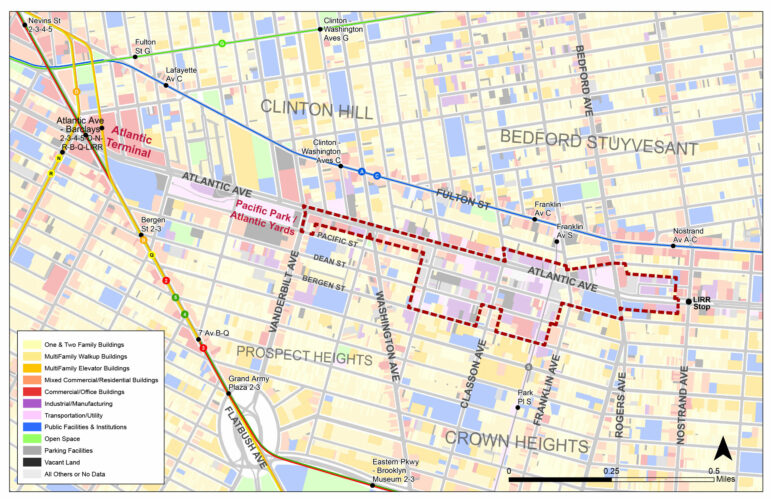Mayor Eric Adams has proposed neighborhood-level rezonings near future Metro-North stations in the East Bronx and along an Atlantic Avenue light manufacturing corridor in Crown Heights and Bedford-Stuyvesant. The local councilmembers say they support both plans.

Adi Talwar
Looking east from 876 Atlantic Ave., within the city’s proposed rezoning area, toward a new tower at 809 Atlantic Ave.Mayor Eric Adams on Thursday released new details about the first two neighborhood-level rezonings pursued by his administration, positioning plans for the East Bronx and Central Brooklyn in a broader strategy to supercharge housing development across New York City.
The mixed-use rezonings, previously discussed by city planning and housing officials following years of preparation, will target neighborhoods around new Metro-North stations set to open in Morris Park and Parkchester/Van Nest in 2027, as well as a light manufacturing corridor along Atlantic Avenue.
Adams said the upzonings are part of strategy to reach his “moonshot” goal of 500,000 new housing units following decades of lagging production in the face of significant population and job increases. His so-called “Get Stuff Built” plan also includes more than 100 proposed tweaks to speed up the land use planning process and make it cheaper for developers to build, with changes to environmental review rules and Department of Building permitting requirements.
“We need more housing. We don’t have enough housing to meet the need that we have,” Adams said Thursday. “Safe, stable, affordable housing cannot be a privilege. It is the foundation of a prosperous society.”
Critics of the announcement have questioned how the city will reach the 500,000-unit goal amid deep staff shortages, and without additional capital funds.
New housing created under the proposals, as well as the two large-scale neighborhood rezonings, would not open for several years.
Building in The Bronx
The Bronx rezoning plan would add 6,000 new homes—at least a quarter of them income-restricted based on the city’s Mandatory Inclusionary Housing rules—to a 46-block stretch along the MetroNorth tracks, including the area adjacent to the large campuses of Jacobi, Calvary and Montefiore Hospitals, according to fact sheet issued by City Hall. Roughly 23,000 jobs are located within a half-mile of the planned Morris Park station, according to planning documents, but the overlapping Council district has produced very little new housing over the past decade.

Michael Appleton/Mayoral Photography Office
New York City Mayor Eric Adams describes his “Get Stuff Built” plan on Dec. 8.Adams said the rezoning would create another roughly 10,000 new jobs, many of them related to the healthcare industry. The proposal mirrors the “transit-oriented development” favored by Gov. Kathy Hochul, who hailed the Bronx plan in a statement Thursday.
“With our state staring down a housing crisis, we will need every community, every town, and every city to do its part to make housing accessible and affordable for all,” Hochul said.
The Department of City Planning has scheduled public hearings on the proposal for Dec. 13 and 15, and a public scoping meeting on Jan. 9. The fact sheet issued by City Hall Thursday says the rezoning application is likely to begin the Universal Land Use Review Procedure (ULURP) by the summer of 2023.
City officials have dubbed the proposed rezoning the “City of Yes Bronx Metro-North Plan.”
The impacted area includes a 28-block stretch near the planned Parkchester/Van Nest station bound by Baker Avenue and Van Nest Avenue to the north, Silver Street to the east, East Tremont Avenue to the south and St. Lawrence Avenue to the west. Another 18-block area adjacent to the future Morris Park station would also be part of the rezoning. The section is bound by Pelham Parkway to the north, Marconi Street to the east, Williamsbridge Road to the south and Tenbroeck Avenue to the west.
The plan would rezone some manufacturing and commercial sections of the neighborhoods for residential use, and increase residential density in other parts, according to planning documents now available on the city’s Zoning Application Portal. Specifically, the plan focuses on low-rise manufacturing zones along East Tremont Avenue in Parkchester, which would be converted to commercial and medium-density residential use. Manufacturing zones around the medical campuses would be changed to commercial, with higher-density residential buildings allowed just south of Montefiore Medical Center.
“The establishment of new transit service in previously auto-oriented areas demands a thoughtful reorientation of permitted uses and densities to capitalize on the state’s significant investment in regional rail,” Draft Scope of Work documents state. “The Proposed Actions would facilitate an area-wide rezoning that would increase density on major streets, large sites, areas adjacent to large institutions and at new transit stations.”
The rezoning plan would not impact parts of the area, like the Indian Village section Morris Park, that are zoned for one- and two-family homes and where neighbors have furiously resisted new development.
Councilmember Marjorie Velázquez, who represents nearly all of the proposed rezoning area, has hesitated to back other development plans in the district—like a Bruckner Boulevard upzoning she ultimately voted for and a supportive housing residence on the Jacobi campus she continues to oppose. On Thursday, she told City Limits she supports the more comprehensive plan put forth by the Adams administration.
“There has been a lot of preliminary conversations and this is the start of something that’s massive,” Velázquez said. “My district will be heavily impacted by this and I’m extremely excited not only for the economic development but what this does to bring real jobs, real dollars and real housing to my community.”
Velázquez, who grew up in the Parkchester-Van Nest area, said the city’s proposal will create housing opportunities for a new generation of New Yorkers.
“We have a housing shortage, and for many families, it’s what kind of housing can they get, what kind of options are there,” she said “Our priority has always been for young people and families to move up, but we don’t have housing for them.”

DCP
Map of existing zoning along near planned Metro-North stations in The Bronx.
DCP
Map of proposed zoning along near planned Metro-North stations in The Bronx.Opportunity on Atlantic Avenue
At the same time, the city will pursue a mixed-use rezoning plan along Atlantic Avenue, between Vanderbilt and Nostrand avenues, that has been in the works for nearly a decade. A 2018 report from Community Board 8 outlined the dual goals of rezoning the M1, or light manufacturing district, “to increase available density for commercial/manufacturing uses mixed with residential” and using “market rate residential development to cross-subsidize affordable housing and manufacturing.”
As City Limits reported Thursday, the area along that stretch of Atlantic Avenue has been the site of piece-meal rezonings, with murky community agreements and shifting ownership.
Community board 8 did not immediately respond to an inquiry for their perspective on the proposal Thursday, but a subcommittee formed in 2013 has welcomed proposed changes for the M-CROWN, or Manufacturing, Commercial, Residential Opportunity for a Working Neighborhood plan. Adams, in his role as borough president, backed the plan in 2018.
In addition to new housing for “thousands” of people, the “plan would also deliver commercial and industrial jobs and infrastructure improvements to Crown Heights and Bedford-Stuyvesant,” Adams said Thursday.

DCP
A map of the proposed rezoning along Atlantic Avenue in Brooklyn.Councilmember Crystal Hudson, who represents much of the proposed rezoning area, told City Limits she supports the proposal building on the M-CROWN plan “that this community has been waiting on for the better part of a decade.”
“Eric Adams was supportive as Borough President, and it is encouraging to know, as Mayor, he continues to support the [Atlantic Avenue Mixed Use Plan], bringing more affordable housing to Central Brooklyn,” Hudson added. “As the plan gets underway, I am excited for the opportunity to engage our neighbors in the visioning of what the future of this corridor could be.”
Hudson previously toured the M-CROWN area with City Planning Director Dan Garodnick in April. During an appearance on WBAI’s City Watch, Garodnick said Hudson and Councilmember Chi Ossé have been deeply involved in conversations over the Atlantic Avenue rezoning.
“We have worked on this issue carefully and thoughtfully in a way that we believe we can do it in partnership with the local councilmembers,” Garodnick said. “We want to do this in a way where the community is seeing these sorts of changes, not feeling threatened by them but rather seeing them as an opportunity to reimagine a neighborhood, to do it in away that respects community interests and creates new opportunities for the people that are there and who may be there in the future.”
A spokesperson for Ossé said he was not available to discuss the announcement or provide a statement.
The Brooklyn plan is expected to begin the ULURP process in 2024, according to a fact sheet issued by City Hall. The first public meeting will likely take place in January 2023.









5 thoughts on “Adams’ First Two Neighborhood Rezonings Take Shape as Mayor Looks to Supercharge Development”
The proposed east Bronx rezoning should wait until the proposed east Bronx MNRR stations are completed. The MTA may abandon the east Bronx project given their chronic financial difficulties.
its not good
now lets see how many years it going to take to build this tower on atlantic ave, maybe 2029, 2030 etc, get stuff built, for who? black and brown residents in that area have drastically shrunk, and continuing to shrink according to a report, all people should be able to get those units when ever they get built, yeah get stuff buid, but quicker
now lets see how many years it going to take to build this tower on atlantic ave, maybe 2029, 2030 etc, get stuff built, for who? black and brown residents in that area have drastically shrunk, and continuing to shrink according to a report, all people should be able to get those units when ever they get built, yeah get stuff build quicker, please
Why has he waited so long to begin neighborhood rezonings? He states a massive goal for affordable housing and then provides a too little too late piecemeal strategy that guarantees failure.